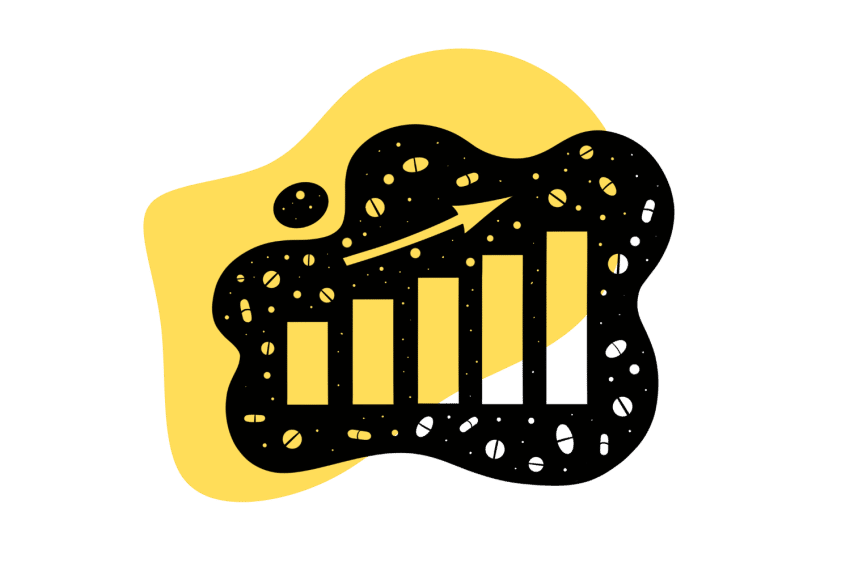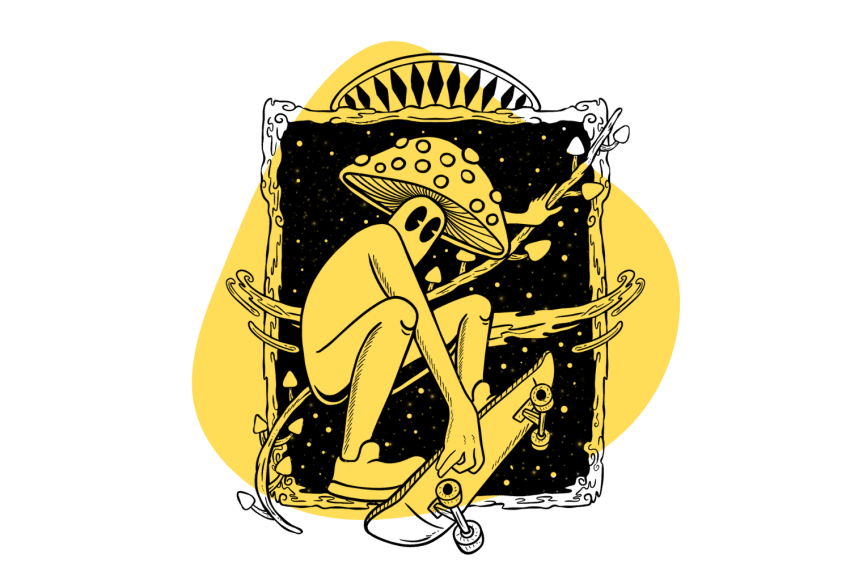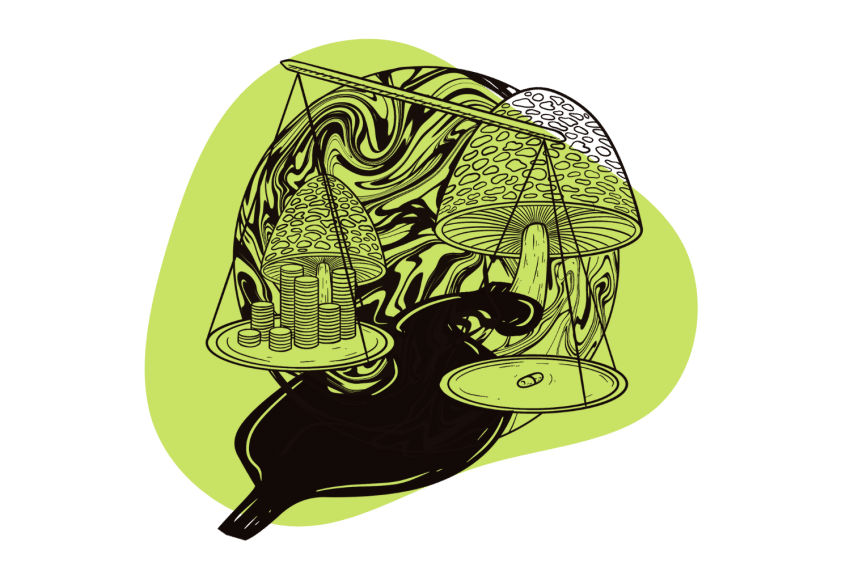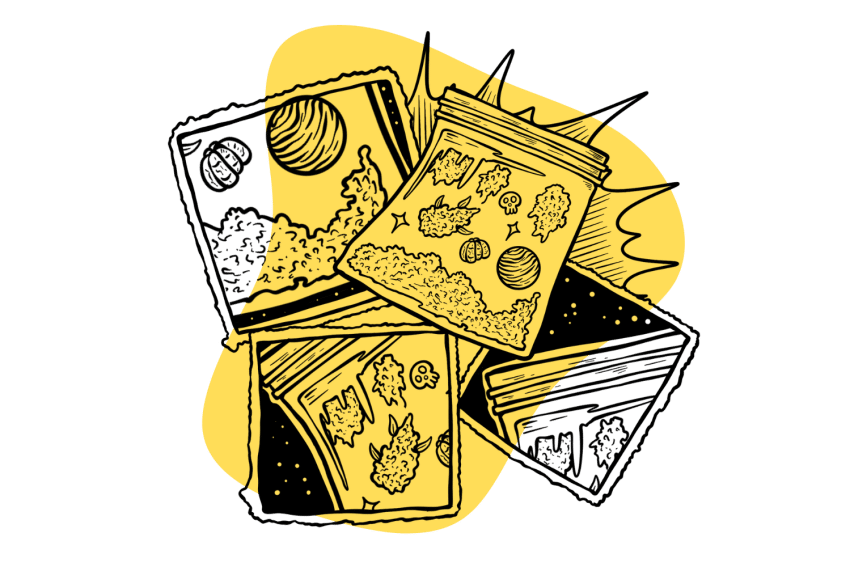Rolling Safe: Using MDMA for the First Time
Using MDMA for the first time is daunting, but preparation can help ensure an enjoyable introductory experience. Use this guide to help properly prepare for your first roll, understand the risks, and ensure you have a great time.
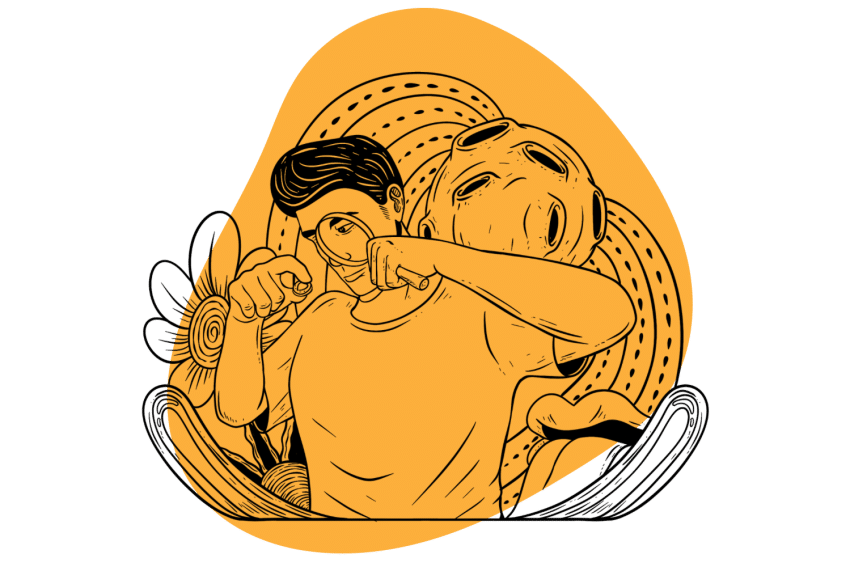
MDMA (3,4-Methylenedioxymethamphetamine,) is one of the most popular festival drugs in existence. Whether you’re dropping at a rave with friends, taking MDMA with your partner for a spicy night in, or participating in psychedelic therapy, you should arm yourself with knowledge and know the risks.
Here’s a quick breakdown of everything we’ll cover in this guide for anyone wanting to “roll” for the first time:
| Chemical Name | 3,4-Methylenedioxymethamphetamine |
| Nicknames | Molly, Ecstasy, Adam, XTC, X, M, Mandy, Pingers, Beans, E-tabs, Disco Biscuits |
| Different Forms | Pill presses, crystal powder |
| Legality | Illegal in most countries, including the US |
| Duration of Effects | 4 to 6 hours |
| Common Side Effects | • Nystagmus • Anxiety • Dry mouth • Increased heart rate • Nausea • Sweating • Teeth grinding • Appetite suppression |
| Typical Dose Range | • Threshold — 20 mg • Light — 20-80 mg • Moderate — 80-120 mg • High — 120-150 mg • Safety Limit — 170 mg |
| Timeline of effects | • Onset — 30-60 minutes after ingestion • Peak — 1.5-2.5 hours in • Comedown — About 4 hours after dosing • Return to Baseline — 4-6 hours with residual stimulation possible for 6-8 hours after dosing. • Afterglow — If you followed best practices, you might have an “afterglow” the next day with an elevated mood |
| Dangers | • Hyponatremia • Dehydration • Serotonin Syndrome • Overheating • Cardiovascular damage • Abuse potential • Harsh comedowns |
| Supplements to help lower side-effects | • Magnesium Glycinate • Alpha Lipoic Acid • Acetyl-L-carnitine (ALCAR) • Vitamin C • Melatonin 5-HTPNAC • Ginger • Green Tea • L-Theanine • Ubiquinone (Co-Q10) |
Tripsitter’s MDMA Safe Trip Checklist
- I’m confident in my dose and know it is appropriate for my environment and experience level.
- Re-dosing protocols are something I understand and have planned for when I will take my single re-dose or have decided not to do so.
- I have taken MDMA or similar serotonin-releasing compounds less than 4 in the last year.
- The day after my experience with MDMA is clear, and I don’t have to worry about burdensome responsibilities.
- I am aware of MDMA interactions and am not on medication that interacts with MDMA.
- I don’t have heart issues, hypertension, or susceptibility to seizures.
- My MDMA passed through reagent tests, and I am confident it is MDMA.
- My setting and mindset are both conducive to a relaxing, enjoyable experience.
- I understand the risk of over & underhydration and have made a plan to drink the proper amount of water.
- I understand the legal status of MDMA in my area and whether or not the choice I make is legal.
- If I mix other drugs with MDMA, I will exercise harm reduction methods and thoroughly research interactions before doing so.
MDMA Pro-Tips
In addition to the guidelines above, here are a few tips for ensuring your experience on MDMA is enjoyable:
- Be selective in who you roll with
- Prepare a 6-8 hr playlist of music
- Create a cozy nest with lots of blankets & pillows
- Have tasty, nutritional snacks and drinks
- Lights and toys are fun
- A short walk is a good way to spend your come-up
While you’re rolling, DO NOT call or text anyone that you wouldn’t want to know you’re rolling. It doesn’t matter how much you love your mom or your new friend. It can wait until the next day.
Don’t put yourself in a position where you’ll worry about whether you are “passing” for sober — you almost definitely will not.
What Should MDMA Look Like? Pills vs. Powder
Pill form — or presses — of MDMA are the type to most commonly receive street names like “Molly” or “Ecstasy.” While the pill form seems like the most user-friendly, I’d recommend against going for this version for two major reasons:
#1. Difficulty with MDMA Dosage
It is impossible to measure when they come in pill form, and they often contain way too high of a dosage (sometimes even 300mg+.) The average MDMA dosage in pill form rose from 110 mg in 2012 to 175mg in 2021 in Zurich, Switzerland.
Pills that contained more than 120 mg MDMA rose from 27% to 86%.
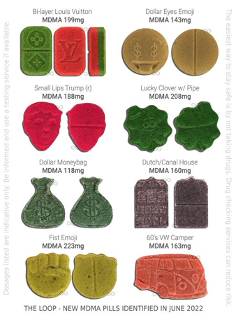
Knowing your dosage and feeling confident in it may be the single most important harm-reduction method for nearly any drug. Psychedelics are dose-dependent and can act very differently when the dosage is higher than anticipated.
With powder, measuring your dosage is much easier since you don’t have to contend with fillers and other unknown elements. Having confidence in your dosage, you can begin to introduce yourself to the world of MDMA more reliably.
#2. Problems with Contamination in MDMA Presses
25% of frequent MDMA users in NYC tested positive for cathinone (bath salts) in hair tests in 2015 [1]. In 2021, 45% of MDMA pills were tested by the harm reduction organization The Loop contained no MDMA [2].
Other drugs are often mixed in with presses, including:
- MDA
- MDEA
- Amphetamine
- Methamphetamine
- Caffeine
- 2C-B
- mCPP
- Cathinones(bath salts)
- Heroin
- Ketamine
- PMA
- PMMA
These and many other drugs commonly pop up in pills marketed as MDMA. Pills are more likely to contain adulterants from the pressing process, and makers of branded pills may add other substances to boost effects and/or reduce costs.
Pills are, therefore, more likely to contain adulterants and a wider range of them than isolated crystals.
How to Perform a Reagent Test With MDMA
Always test your MDMA with Marquis, Mecke, and Simon’s A/B reagents. Marquis is the most important, determining samples are clear of meth, PMA, PMMA, or a cathinone substance — drugs often found in ‘MDMA’ samples.
Here’s how to test an MDMA sample with a Marquis reagent:
- Place a small sample on the white, ceramic dish — no need to overdo it, a pinhead-sized amount is perfectly acceptable
- Without letting the dropper touch the sample, drop a single drop of reagent onto the sample.
- Observe the color change — MDMA should turn purple and then black in about 30 seconds.

MDMA crystals should be white, even if you’ve heard of “purple” or “brown sugar molly.” Any color is a sign of an incomplete synthesis — ‘brown sugar molly’ often contains MDA in addition to the MDMA, failing to process the precursor safrole completely.
What Should My MDMA Dosage Be?
The standard MDMA dose should be around 80-120 mg — higher tolerances, or people with a higher weight may go up to 150 mg. We highly recommend you don’t exceed this amount as taking more doesn’t increase the euphoric components, it only elevates side effects and risks.
The Multidisciplinary Association for Psychedelic Sciences (MAPS) showcased this in a trial for MDMA treatment on Post-Traumatic Stress Disorder (PTSD [3].) You can see this effect on the chart below, plotting a first session using 80 mg with a 40 mg booster and the second session with 120 mg and a 60 mg booster.
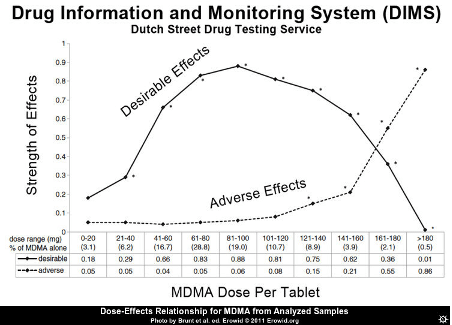
Can You Re-Dose MDMA?
Re-dosing MDMA is a common practice by psychonauts who aren’t quite ready to make the journey back to baseline. You can only re-dose MDMA once — it won’t increase the effects, but it will lengthen the timeline of your roll by about 2 hours.
If you re-dose, do so 2 hours after your first dose and don’t exceed 50% of your original dose.
What is the Timeline of MDMA?
Understanding the timeline of your substance is important for handling the experience and preparing for what’s to come. Here’s what to look forward to when taking a “roll” around the block with MDMA:
1. Onset of Effects
The first effects of MDMA will become apparent around 30-60 minutes after ingestion. During this time, you may experience nausea, anxiety, tactile enhancement, or a strange stimulation. Once this strange feeling turns into euphoria, you have successfully made it past the come up and you’re well on your way.
2. Peak
Expect the heaviest part of the experience to be between 1.5-2.5 hours in. During this time, the euphoria, tactile enhancement, energy, feelings of love, sociability, and connection will overtake you. Some describe the experience as “being hugged by everyone who loves you in a bathtub full of puppies licking your face.”
3. Comedown
About 4 hours after dosing, you will start to come down. The first thing most people notice is a fading of the euphoria and any residual side effect(s) becoming more noticeable.
4. Return to Baseline
Acute MDMA effects will end in 4-6 hours, and residual stimulation can continue for 6-8 hours after dosing. After any remaining stimulation ends, you return to baseline in 8 hours max.
5. Afterglow
If you followed the harm reduction tips, stayed hydrated, didn’t overheat, and had a good night of sleep, you might have an afterglow the next day. An MDMA afterglow is an uplifting feeling, similar to how you might feel on a really good day or after a microdose.
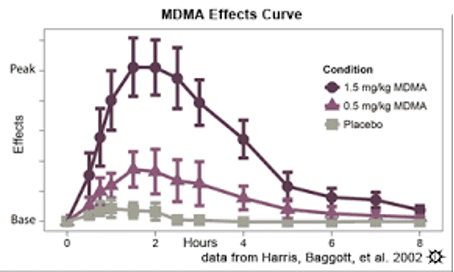
Safety Tips When Using MDMA
Expect a significant reduction or delay in effects if you take MDMA on a full stomach. Eat a healthy, light meal 3-4 hours before to ensure you feel your best and have the strongest effect possible.
The most common side effects are nystagmus (uncontrolled eye movements) [4], anxiety, dry mouth, sweating, increased heart rate, nausea [5], gumming/teeth grinding [6], and more. Staying hydrated — ideally 8–16oz of an electrolyte-containing beverage per hour — can help.
Water is the next best option — if you’re in a hot environment, stick to the higher end of this range. While on MDMA, you should stay hydrated, but overhydrating can also be a problem, so take it slow.
The euphoria can make it easy to drink too much water, causing hyponatremia — when your body is over-hydrated, causing sodium levels to drop [7]. To reduce this risk, drink water slowly and limit yourself to 2 cups an hour.
Hyponatremia symptoms include nausea, vomiting, headache, confusion, and fatigue.
If this happens, you should immediately:
- Stop water intake
- Eat salty snacks
- Get ready for possible medical attention
If you’re on the fence, always err on the side of seeking help. Remember, it’s better to get medical attention and not need it than the other way around.
Losing The Magic: MDMA Tolerance
If you roll too often, you might “lose the magic,” — meaning you won’t get high from MDMA anymore. The technical term for this is tolerance.
To combat this, Ann Shulgin created the 3-month rule, estimating you should only partake in MDMA once a quarter.
Currently, the only thing we know for a fact is that the more you roll, the more likely you are to “lose the magic.” MDMA exhibits cross-tolerance with all dopaminergic and serotonergic stimulants, reducing the effect of all of them for up to months at a time [8].
For those missing their magic, anecdotal reports indicate the supplement NAC might bring back MDMA effects — though this is obviously inconclusive.

Neurotoxicity of MDMA
MDMA neurotoxicity — or, damaging effect on the brain — is something research has shown in animals but has yet to prove within humans. While researchers have worked out theories surrounding the matter, it’s hard to do so in humans.
It seems the most likely people to have a toxic reaction to MDMA are those who use it along with other drugs [9] or use large and/or frequent doses [10]. Additionally, overly hot environments or dehydration could make the metabolization of the compound harder and contribute to the problem.
Take breaks from hot environments like crowds, dancing, and hot tubs. Use ice on your neck/forehead if you feel light-headed, overheated, or clammy or are getting muscle cramps. Overheating is the biggest risk factor for complications.
Finally, take breaks and be smart about your dosage — respect the drug now, and it will respect you later.
Supplementing for MDMA
I recommend including supplements as a harm-reduction strategy to improve your roll, help with side effects, and brighten the days after. Rollsafe includes more, along with the science on why these supplements are important if you want to learn more.
Magnesium glycinate might help reduce jaw clenching, and the rest may help with neuroprotection:
Most Important:
- Magnesium Glycinate
- Alpha Lipoic Acid or Acetyl-L-carnitine (ALCAR)
Other supplement options include:
- Vitamin C
- Melatonin
- 5-HTP
- NAC
- Ginger
- Green Tea
- L-Theanine
- Ubiquinone (Co-Q10)
Some prefer taking supplements every hour before and during their roll, but I split them into 4 rounds:
- First — 2 hours before dosing
- Second — With the MDMA dose
- Third — 2 hours after the dose
- Fourth — 6 hours after the dose
WARNING: Avoid the supplement 5-HTP within 24 hours of MDMA consumption. It can cause serotonin syndrome, a rare and potentially fatal reaction [11].
Other drugs to avoid include: 25X-NBOMe, 5-MeO tryptamines, alcohol, cocaine, DOX series, GHB/GBL, MXE, PCP, lithium, Tramadol, MAOIs, SSRIs, SNRIs, AMT, 2C-T-X series, DXM, 4-FA, methamphetamine, methylene, other serotonin releases.
Preventing Comedowns and Adverse Reactions To MDMA
“Blue Mondays” — the hangover some users experience after taking MDMA — may come from a few different factors.
Some of these include:
- Unclean MDMA
- Overheating
- Dehydration/overhydration
- Lack of sleep
- Physiological makeup
I have rolled ~12 times — always using supplements — and we have never experienced a comedown, only afterglows. Ensure you’re taking a clean and proper dose of MDMA, don’t take it late at night, stay cool and appropriately hydrated, and you’ll likely avoid a comedown.
Like an LSD trip, you should make sure you have nothing scheduled for the next day — MDMA is incredible but exhausting. Giving yourself a day of recovery is a necessary step toward self-care.
Avoid MDMA if you have any of these contraindicated conditions:
- Cardiovascular disease
- Cerebrovascular disease
- Uncontrolled hypertension
- Malignant hyperthermia
- Anhydrosis
- Central core disease
- Susceptibility to seizures
- Liver problems.
Taking MDMA With People You Feel Safe With
MDMA has an easier headspace than classic psychedelics, but the set, setting, and dose are just as crucial. Taking MDMA with the wrong people, taking too much, or going in with a negative mindset or setting will increase the odds of an adverse experience.

Another pitfall MDMA users run into is mistaking MDMA emotions for real emotions. You may truly believe that you fell in love with that person you just met, but it’s likely just the flood of serotonin and oxytocin in your brain.
Be careful who you take MDMA with and consider how many (if any) strangers you want around. MDMA lowers boundaries and increases empathy which can make it easy to manipulate someone under the influence.
Combining MDMA with Other Drugs
Some drugs are safer than others to combine but any combination carries a risk. Above all else, avoid alcohol while rolling.
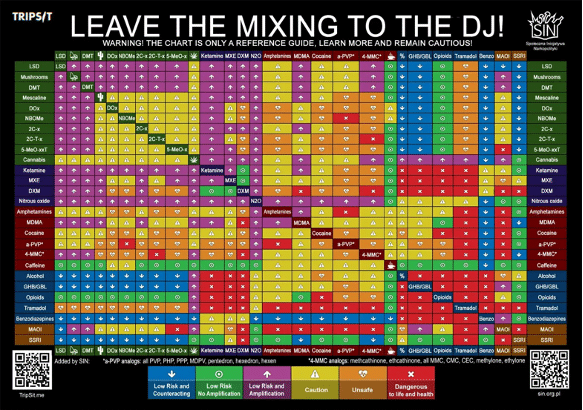
If you smoke cannabis regularly, try to avoid it until coming down from MDMA. It can cloud the high & take away some of the euphoria if you smoke during the peak.
However, it’s can be a great tool for the come down — people often experience anxiety around this, and smoking can help make it more enjoyable.
Also, for people with penises sustaining an erection on MDMA is difficult but avoid taking medication for it without knowing you have an exceptionally healthy heart. Erectile dysfunction medication can increase cardiovascular stress, compounding with the amphetamine component of the MDMA
MDMA Risks
In one study, 28% of long-term users — taking 2-3 doses/week for ~6 years, avg — developed valvular heart disease [12]. MDMA tolerance happens immediately and can take at least 1 month for tolerance to reduce to half (2.5 months to return to baseline.)
This is the reasoning behind Ann Shulgin’s 3-month rule. Her belief was in a maximum of 4 MDMA sessions a year to prevent losing the magic.
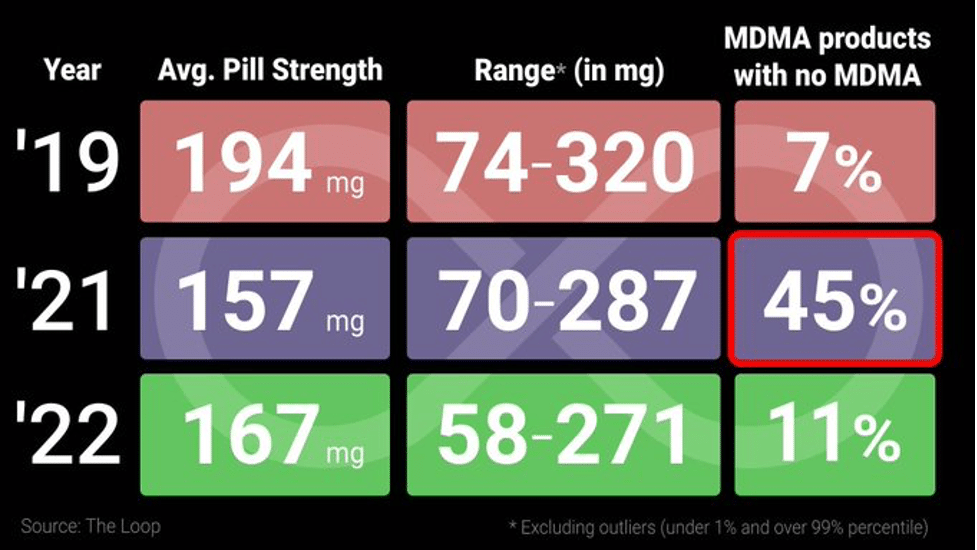
MDMA may also cause excessive stress to the immune system [13], making you more likely to catch contagious diseases when you’re in crowded venues. NAC, Vitamin C, Zinc, and supplements like Airborne or Emergen-C may help give your immunity a helpful boost.
Final Thoughts: Staying Safe With MDMA
Since being popularized by Ann and Alexander Shulgin in the 1980s, party-goers and therapy communities alike have loved MDMA and “raved” about its potential. The euphoria, lack of fear, and increased connection make it a great drug for many circumstances.
But it is not without risks. If you follow the tips above, you can reduce your risk of adverse experiences, overdoses, or the dreaded comedown. Preparation and education help ensure success whenever psychedelics are involved — ecstasy isn’t any different.
References
- Palamar, J. J., Salomone, A., Vincenti, M., & Cleland, C. M. (2016). Detection of “bath salts” and other novel psychoactive substances in hair samples of ecstasy/MDMA/“Molly” users. Drug and Alcohol Dependence, 161, 200-205.
- MJ, P., & HTD, S. (2022). The Cathinone Hydra: Increased Cathinone and caffeine adulteration in the English MDMA market after Brexit and COVID-19 lockdowns. Drug Science, Policy and Law, 8, 20503245221099209.
- Mitchell, J. M., Bogenschutz, M., Lilienstein, A., Harrison, C., Kleiman, S., Parker-Guilbert, K., … & Doblin, R. (2021). MDMA-assisted therapy for severe PTSD: a randomized, double-blind, placebo-controlled phase 3 study. Nature Medicine, 27(6), 1025-1033.
- Peragallo, J., Biousse, V., & Newman, N. J. (2013). Ocular manifestations of drug and alcohol abuse. Current Opinion in Ophthalmology, 24(6), 566.
- Davison, D., & Parrott, A. C. (1997). Ecstasy (MDMA) in recreational users: self‐reported psychological and physiological effects. Human Psychopharmacology: Clinical and Experimental, 12(3), 221-226.
- Arrue, A., Gómez, F. M., & Giralt, M. T. (2004). Effects of 3, 4‐methylenedioxymethamphetamine (‘Ecstasy’) on the jaw‐opening reflex and on the α2‐adrenoceptors which regulate this reflex in the anesthetized rat. European Journal of Oral Sciences, 112(2), 127-133.
- Campbell, G. A., & Rosner, M. H. (2008). The agony of ecstasy: MDMA (3, 4-methylenedioxymethamphetamine) and the kidney. Clinical Journal of the American Society of Nephrology, 3(6), 1852-1860.
- Baumann, M. H., Clark, R. D., Franken, F. H., Rutter, J. J., & Rothman, R. B. (2008). Tolerance to 3, 4-methylenedioxymethamphetamine in rats exposed to single high-dose binges. Neuroscience, 152(3), 773-784.
- Gouzoulis-Mayfrank, E., & Daumann, J. (2006). The confounding problem of polydrug use in recreational ecstasy/MDMA users: a brief overview. Journal of Psychopharmacology, 20(2), 188-193.
- Parrott, A. C., Sisk, E., & Turner, J. J. D. (2000). Psychobiological problems in heavy ‘ecstasy’(MDMA) polydrug users. Drug and Alcohol Dependence, 60(1), 105-110.
- Maffei, M. E. (2020). 5-Hydroxytryptophan (5-HTP): Natural occurrence, analysis, biosynthesis, biotechnology, physiology, and toxicology. International Journal of Molecular Sciences, 22(1), 181.
- Droogmans, S., Cosyns, B., D’haenen, H., Creeten, E., Weytjens, C., Franken, P. R., … & Van Camp, G. (2007). Possible association between 3, 4-methylenedioxymethamphetamine abuse and valvular heart disease. The American Journal of Cardiology, 100(9), 1442-1445.
- Connor, T. J. (2004). Methylenedioxymethamphetamine (MDMA, ‘Ecstasy’): a stressor on the immune system. Immunology, 111(4), 357-367.



